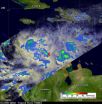(Press-News.org) University of Illinois researchers have confirmed the first report of a potential new virus belonging to the genus Marafivirus in switchgrass, a biomass crop being evaluated for commercial cellulosic ethanol production.
The virus is associated with mosaic and yellow streak symptoms on switchgrass leaves. This virus has the potential of reducing photosynthesis and decreasing biomass yield. Members of this genus have been known to cause severe yield losses in other crops. For example, Maize rayado fino virus (MRFV), a type member of the genus, has been reported to cause yield reductions in corn grown in Mexico, Central America and South America.
"Viral diseases are potentially significant threats to bioenergy crops such as Miscanthus x giganteus, energycane and switchgrass," said Bright Agindotan, research associate working in Carl Bradley's laboratory as part of the Energy Biosciences Institute (EBI) located in the Institute for Genomic Biology at the U of I. "Our team at EBI has been charged with identifying potential pests and pathogens of these bioenergy crops."
Until recently, little has been known about viruses in these bioenergy crops. Agindotan said most plants can be infected with multiple viruses, making it a challenge to know which viruses to start screening for, especially when only a few viruses have been reported to affect these crops.
Agindotan developed a method that allows for the identification of a virus without prior knowledge of it. He successfully used sequence-independent amplification (SIA) to identify RNA viruses. This is the first time it has been fully described and used for plant virus identification.
The method involves virus partial purification for a small amount of infected leaf tissue, extraction of viral RNA, random amplification, cloning, sequencing, and searching databases to identify the virus.
"Sequence-independent amplification has a distinct advantage over other virus characterization techniques in that it does not require specific reagents to target viruses," he said. "This test will help us specifically identify uncharacterized viruses. In other words, you don't have to know which virus you are looking for, exactly, to able to be able to identify the virus causing the problem."
The identified virus in switchgrass is different, but related to the MRFV that has been reported to infect corn elsewhere, but has never been reported in Illinois.
The Marafivirus was identified in switchgrass from a U of I research field near campus, where 20 to 30 percent of the plot was infected with this virus.
"We are still working on identifying the insects that are responsible for transmitting it," he said. "We know that its MRFV relative is transmitted by leafhoppers in corn, but we are still trying to confirm the exact species that transmit this virus in switchgrass."
At this time, researchers cannot confirm if this virus affects other crops.
"We don't yet know if the Marafivirus in switchgrass evolved from the one that infects maize or vice versa," he said.
Developing biomass crops that do not harbor pathogens that can spread to nearby cultivated food crops such as cereals is a high priority for plant breeders. This discovery will help plant breeders develop resistant varieties, Agindotan said.
The group will report the full genome sequence of the switchgrass virus soon.
INFORMATION:
This study, "Application of sequence-independent amplification (SIA) for the identification of RNA viruses in bioenergy crops," was published in the Journal of Virological Methods. Researchers include Bright Agindotan, Monday Ahonsi, Leslie Domier, Michael Gray and Carl Bradley, all of the U of I.
The EBI is a collaboration between the University of California's Berkeley campus, the federal Lawrence Berkeley National Laboratory, and the University of Illinois at Urbana-Champaign, funded by energy corporation BP. The unique public-private partnership is in its third year of studying the prospects for, and impacts of, alternative transportation fuels and microbial hydrocarbon recovery. The portfolio currently stands at more than 70 awarded studies.
University of Illinois researchers discover potential new virus in switchgrass
2010-11-04
ELSE PRESS RELEASES FROM THIS DATE:
Physics experiment finds violation of matter/antimatter symmetry
2010-11-04
ANN ARBOR, Mich.---The results of a high-profile Fermilab physics experiment involving a University of Michigan professor appear to confirm strange 20-year-old findings that poke holes in the standard model, suggesting the existence of a new elementary particle: a fourth flavor of neutrino.
The new results go further to describe a violation of a fundamental symmetry of the universe asserting that particles of antimatter behave in the same way as their matter counterparts.
Neutrinos are neutral elementary particles born in the radioactive decay of other particles. The ...
Yale journal explores new environmental applications of ICT
2010-11-04
New Haven, Conn. -- New applications of information and communication technology (ICT) that could save society significant amounts of energy and money and reduce greenhouse gas emissions that are warming the planet are explored in a special issue of Yale's Journal of Industrial Ecology.
These applications exploit recent advances in ICT, such as social networking and Web 2.0, smart energy monitoring and geographic information systems, and are explored in depth in the special issue "Environmental Applications of ICT," published with support from the Leading Edge Forum ...
NASA's TRMM satellite sees Tomas' power fluctuate
2010-11-04
The Tropical Rainfall Measuring Mission (TRMM) satellite traveled over Tomas twice on Tuesday, Nov. 2. The second time was at 2005 UTC (4:05 p.m. EDT) when it was still classified as a tropical storm. During TRMM's second overpass, Tomas' center of circulation wasn't evident. Today, Nov. 3 that center is reforming.
During the morning hours on Nov. 3, an Air Force hurricane hunter aircraft found no tropical storm force winds so Tomas was downgraded by the National Hurricane Center to a tropical depression.
At 2 p.m. EDT on Nov. 3, Tomas was undergoing some changes, and ...
What will Webb see? Supercomputer models yield sneak previews
2010-11-04
VIDEO:
Two spiral galaxies undergo a protracted crash lasting two billion years, eventually merging into a single elliptical galaxy.
Click here for more information.
As scientists and engineers work to make NASA's James Webb Space Telescope a reality, they find themselves wondering what new sights the largest space-based observatory ever constructed will reveal. With Webb, astronomers aim to catch planets in the making and identify the universe's first stars and galaxies, yet ...
Prostate cancer's multiple personalities revealed
2010-11-04
NEW YORK (Nov. 3, 2010) -- Scientists at Weill Cornell Medical College have taken an important step toward a better understanding of prostate cancer by uncovering evidence that it is not one disease, as previously believed, but rather several factors which can be measured and, in the future, destroyed by targeted therapy.
The research team led by of Dr. Mark A. Rubin, the Homer T. Hirst Professor of Oncology in Pathology and vice chair for experimental pathology at Weill Cornell Medical College, identified secondary mutations that cause some types of prostate cancer ...
Half of those travelling internationally not aware of potential health risks
2010-11-04
More than 30 million people in the United States travel to resource-limited areas of the world each year. This global mobility may contribute to the spread of infectious diseases – such as influenza, measles, and meningitis – and may also put individual travelers at risk for malaria, typhoid, dengue fever and hepatitis. Despite these potential risks, a recent study conducted by the Division of Infectious Diseases at Massachusetts General Hospital (MGH) and published in the Journal of Travel Medicine found that 46 percent of travelers to resource-limited countries did ...
New lymphoma therapy may be more effective with fewer side effects
2010-11-04
NEW YORK (Nov. 3, 2010) -- Diffuse large B-cell lymphoma (DLBCL) is a type of aggressive non-Hodgkin's lymphoma that accounts for approximately 40 percent of lymphomas among adults. If left untreated, it is fatal. The existing treatments have a cure rate that is slightly over 50 percent but destroy healthy cells along with the cancer cells.
Researchers at Weill Cornell Medical College have found a combination therapy that is more effective than traditional treatments and is able to kill the cancer cells without harm to surrounding tissues. In a paper published in the ...
Medication adherence improves blood pressure control in chronic kidney disease
2010-11-04
CINCINNATI—Researchers at the University of Cincinnati (UC) and the Cincinnati Veterans Affairs (VA) Medical Center have found that about one-third of chronic kidney disease patients who are prescribed therapies for high blood pressure do not often adhere to treatments.
This report was published in the Nov. 2 online edition of the American Journal of Nephrology.
The study, led by researchers at UC and the Cincinnati VA, showed that treatment of hypertension in patients with chronic kidney disease continues to be a challenge in their care and that by simply improving ...
New research shows disparities in hospice enrollment are not likely related to access
2010-11-04
Researchers at Mount Sinai School of Medicine have found that 98 percent of the U.S. population lives in communities within 60 minutes of a hospice provider, suggesting that disparities in use of hospice are not likely due to a lack of access to a hospice provider. The results are published in the current issue of the Journal of Palliative Medicine.
"Despite a significant increase in the availability of hospice services during the past decade, the majority of Americans die without hospice care," said Melissa D.A. Carlson, PhD, Assistant Professor of Geriatrics and Palliative ...
Cell membranes behave like cornstarch and water
2010-11-04
VIDEO:
Video opens with footage of a common cornstarch and water experiment. Ian Oberst, a visiting student from Portland Community College who participated in the University of Oregon's UCORE program for...
Click here for more information.
Mix two parts cornstarch and one part water. Swirl your fingers in it slowly and the mixture is a smoothly flowing liquid. Punch it quickly with your fist and you meet a rubbery solid -- so solid you can jump up and down on a vat of it.
It ...

